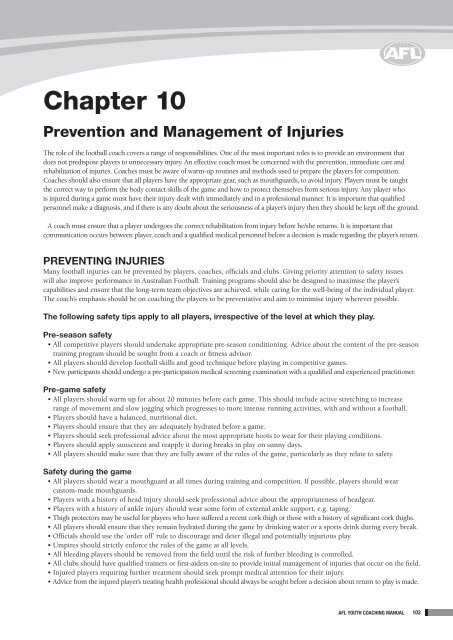2012 Youth Coaching Manual - AFL Community
2012 Youth Coaching Manual - AFL Community
2012 Youth Coaching Manual - AFL Community
Create successful ePaper yourself
Turn your PDF publications into a flip-book with our unique Google optimized e-Paper software.
Chapter 10<br />
Prevention and Management of Injuries<br />
The role of the football coach covers a range of responsibilities. One of the most important roles is to provide an environment that<br />
does not predispose players to unnecessary injury. An effective coach must be concerned with the prevention, immediate care and<br />
rehabilitation of injuries. Coaches must be aware of warm-up routines and methods used to prepare the players for competition.<br />
Coaches should also ensure that all players have the appropriate gear, such as mouthguards, to avoid injury. Players must be taught<br />
the correct way to perform the body contact skills of the game and how to protect themselves from serious injury. Any player who<br />
is injured during a game must have their injury dealt with immediately and in a professional manner. It is important that qualified<br />
personnel make a diagnosis, and if there is any doubt about the seriousness of a player’s injury then they should be kept off the ground.<br />
A coach must ensure that a player undergoes the correct rehabilitation from injury before he/she returns. It is important that<br />
communication occurs between player, coach and a qualified medical personnel before a decision is made regarding the player’s return.<br />
Preventing injuries<br />
Many football injuries can be prevented by players, coaches, officials and clubs. Giving priority attention to safety issues<br />
will also improve performance in Australian Football. Training programs should also be designed to maximise the player’s<br />
capabilities and ensure that the long-term team objectives are achieved, while caring for the well-being of the individual player.<br />
The coach’s emphasis should be on coaching the players to be preventative and aim to minimise injury wherever possible.<br />
The following safety tips apply to all players, irrespective of the level at which they play.<br />
Pre-season safety<br />
• All competitive players should undertake appropriate pre-season conditioning. Advice about the content of the pre-season<br />
training program should be sought from a coach or fitness advisor.<br />
• All players should develop football skills and good technique before playing in competitive games.<br />
• New participants should undergo a pre-participation medical screening examination with a qualified and experienced practitioner.<br />
Pre-game safety<br />
• All players should warm up for about 20 minutes before each game. This should include active stretching to increase<br />
range of movement and slow jogging which progresses to more intense running activities, with and without a football.<br />
• Players should have a balanced, nutritional diet.<br />
• Players should ensure that they are adequately hydrated before a game.<br />
• Players should seek professional advice about the most appropriate boots to wear for their playing conditions.<br />
• Players should apply sunscreen and reapply it during breaks in play on sunny days.<br />
• All players should make sure that they are fully aware of the rules of the game, particularly as they relate to safety.<br />
Safety during the game<br />
• All players should wear a mouthguard at all times during training and competition. If possible, players should wear<br />
custom-made mouthguards.<br />
• Players with a history of head injury should seek professional advice about the appropriateness of headgear.<br />
• Players with a history of ankle injury should wear some form of external ankle support, e.g. taping.<br />
• Thigh protectors may be useful for players who have suffered a recent cork thigh or those with a history of significant cork thighs.<br />
• All players should ensure that they remain hydrated during the game by drinking water or a sports drink during every break.<br />
• Officials should use the ‘order off’ rule to discourage and deter illegal and potentially injurious play.<br />
• Umpires should strictly enforce the rules of the game at all levels.<br />
• All bleeding players should be removed from the field until the risk of further bleeding is controlled.<br />
• All clubs should have qualified trainers or first-aiders on-site to provide initial management of injuries that occur on the field.<br />
• Injured players requiring further treatment should seek prompt medical attention for their injury.<br />
• Advice from the injured player’s treating health professional should always be sought before a decision about return to play is made.<br />
<strong>AFL</strong> <strong>Youth</strong> <strong>Coaching</strong> <strong>Manual</strong><br />
103

















